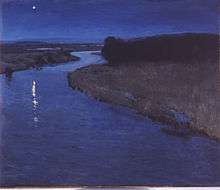Eugen Bracht
| Eugen Bracht | |
|---|---|
 Bracht – photo by Nicola Perscheid (1917) | |
| Born |
June 3, 1842 Morges, Waadt, Switzerland |
| Died |
November 5, 1921 (aged 79) Darmstadt, Hesse, Germany |
| Resting place | Darmstadt, Hesse, Germany |
| Nationality | German |
| Alma mater | Academy of Fine Arts, Karlsruhe |
| Known for | Painting |
| Movement | Romanticism, Symbolism, Impressionism |
Eugen Felix Prosper Bracht (3 June 1842 – 5 November 1921) was a German landscape painter.
Biography
Bracht was born in Morges, Waadt (near Lake Geneva in Switzerland) of German parents. Then he moved with his parents to Darmstadt, Germany where he was a pupil of Karl Ludwig Seeger at the Academy of Fine Arts, Karlsruhe. Later he studied under Hans Gude in Düsseldorf. Dissatisfied with his work, in 1864 he moved to Berlin and became a merchant. In 1876 he decided to become a painter after all and he joined his former teacher in Karlsruhe. He mostly painted landscapes and was one of the famous painters of the late Romanticism in Germany.
He was known for landscapes and coastal scenes in North Germany, and in 1880 and 1881, he made a sketching trip through Syria, Palestine and Egypt. In 1882 he became a Professor of Landscape Painting at the Prussian Academy of Arts. In 1885 he painted the Battle of Chattanooga for the "Philadelphia Panorama Company", a cyclorama which was installed in Philadelphia and Kansas City.
Bracht was supported by Anton von Werner, the conservative director of the Berlin Academy, but broke off with him during the affair of the closure of Edvard Munch's Berlin exhibition in 1892.[1]
When von Werner died, Bracht finished a panorama of the Battle of Sedan which Werner had begun. Later he became a representative of German Impressionism.
In 1901 he obtained a teaching position at the Dresden Academy of Fine Arts that he held until 1919. After his retirement he lived in Darmstadt, where he died in 1921.
Selected paintings
Notes
External links
![]() Media related to Eugen Bracht at Wikimedia Commons
Media related to Eugen Bracht at Wikimedia Commons



.jpg)